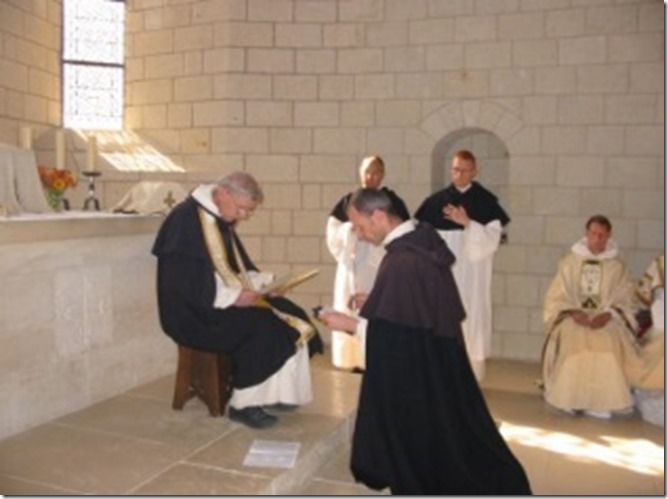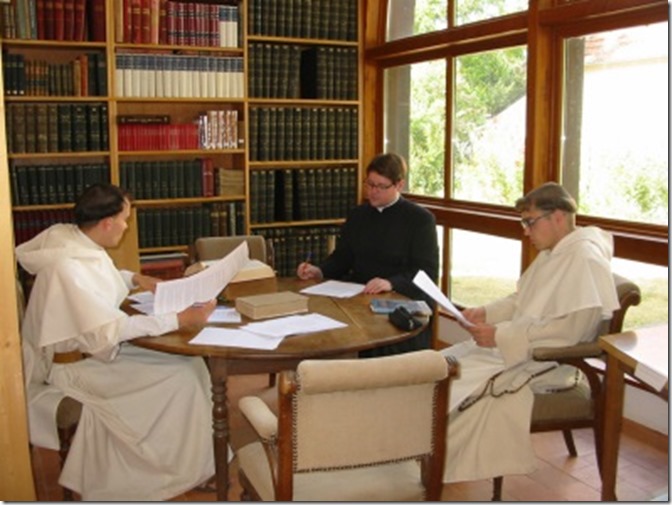Vatican II Put Into a Code of Laws
The New Code of Canon Law (1983)
by a Dominican Father of Avrillé
(published in Le Sel de la terre 120, Spring 2022)
When error is once embodied in legal formulas and administrative practices, it penetrates the minds to depths from which it becomes as if impossible to extricate it.
Cardinal Pie, Pastoral Works, VI.
Preamble: Is Canon Law Amiable?
When a priest makes this cheerful comment to one of his confreres: “So you study Canon Law?” one can easily guess some ulterior motive which could be translated as follows: “What a turn of mind you have!” or again: “What courage!”
Is Canon Law really so boring? Is it so abstract, so cold, so unpleasant? We would like to prove here how lovable it is in itself, lovable especially because it introduces us, like theology, to the heart of the Church and to the Heart of Christ1.
It was of the traditional Code of Canon Law, that of 1917, that Father Coache spoke in these terms in the 1980s. But first of all, what is Law?
In French, Canon Law is translated “Droit canon”, and the French word Droit (in Latin Jus) comes from the Latin words dirigere and regere. In this case, it means a set of laws intended to direct us, to govern us. As for the word “canon“, it comes from a Greek word which means: rule.
We can now define Canon Law:
Canon Law is the body of laws proposed, established or approved by the supreme ecclesiastical authority, to direct Christians towards the end of religious society2.
A classic commentary adds the following clarification:
The subjects of ecclesiastical law are Christians, that is, all those who have received baptism, even if they are heretics, schismatics, excommunicated or even apostates.
As for the end of religious society, it is none other than the salvation of men, and, more immediately, the preservation of divine worship, of the purity of the faith and of honesty of morals among the Christian people in general3.
It is important to note the link between Canon Law and theology:
– it can be said to protect dogmatic theology, laying down rules to preserve the purity of the faith, in particular laws on teaching, prescriptions on professions of faith, censures against heresy and schism4;
– It supports moral theology as from the outside, for if moral theology orders human acts (interior and exterior) to personal eternal salvation, Canon Law has as its object the exterior acts of the baptized in their relation to the social good of the Church on this earth, to enable her to work for the salvation of souls and the reign of Our Lord over societies. Canon Law does not judge the internal forum of consciences, which is reserved for the confessional. Hence the adage: de internis Ecclesia non judicat.
The Code of Canon Law is therefore as important in the Church as dogma, morals, or the science of the Holy Scriptures. It shows the face of the Church and of Christ in their magnificent justice and their sweet mercy. It is the legislation of Christ and of His Bride, an expression of the Love of Our Lord and of His Church for their children. It is the Code of Canon Law that makes known to us the spirit of the Church. It is therefore lovable, and we must respect and love it5 .
Two Codes, Two Stories
The 1917 Code
– The Sources of Traditional Canon Law
The Supreme Pontiff and the General Councils are the two immediate sources of Canon Law; and since the decrees of the General Councils have authority only through papal approval, it can be said that papal authority is the primary generative source of General Canon Law6 .
– From the Apostles to the 12 th century: the birth of ecclesiastical legislation
In the early days, the discipline of the Church was not regulated by written laws, but by an oral tradition which came from the Apostles and the first successors of Peter. Gradually, especially after the era of persecution, synods began to be held in which decrees or canons were issued, forming the first texts of ecclesiastical law. They were gathered in collections bearing the name of the Apostles (Didascalia7 of the Apostles, Constitutions of the Apostles, Canons of the Apostles, etc.) or of some great ecclesiastical figure (Octateuch of Clement, Canons of Hippolytus, etc.). These are compilations of local customs or conciliar decisions, but they do not go back further than the third century8 .
From the 4 th century onwards, there are collections of different conciliar decisions classified by region and chronological order (Councils of Africa, Councils of Spain, etc.) and Decretals of popes.
The most famous canonical collection is the Decree of Gratian, published around 1145 in Bologna, which groups in a logical order and comments all the texts available at the time. John Gratian was an Italian Camaldolese monk and professor of Canon Law at the University of Bologna. His collection had the same notoriety and influence as the Sentences of Peter Lombard for theology.
– From the 12 th to 16th century: stabilization of the Law
After the Decree of Gratian, several ecumenical councils were held, and the great popes of the time, Alexander III (pope from 1159 to 1181) and Innocent III (pope from 1198 to 1216) in particular, had made a number of important decisions for the whole Church. The decrees of the Fourth Lateran Council (1216) provided the main basis for the Church’s legislation until the Council of Trent.
Gregory IX (pope from 1227 to 1241) commissioned his chaplain, the Dominican St. Raymond de Pennafort (1175-1275), to compile a collection of them. These were the Decretals of Gregory IX, published in 1234, the most important official canonical collection until the Code of 1917.
At the beginning of the 16 th century, a Corpus Juris canonici was published, including the Decree of Gratian, the Decretals of Gregory IX and the documents of the following popes.
– From the 16 th to the 20 th century: the crowning of the Law
The decrees of the Council of Trent (1545-1563) and the promulgation of new laws soon made the Corpus Juris canonici insufficient. Several popes tried to complete it, while new collections, due to private initiative, were created.
At the time when St. Pius X (pope from 1903 to 1914) ascended to the See of Peter, it was difficult to find one’s way through the ecclesiastical legislation.
[It was] an enormous mass of documents scattered in so many volumes and without any order, many of which were not real laws, but answers to particular cases, or had been abrogated by later laws or by custom9 .
[Moreover, many of these laws], because of the changes that had taken place, were of difficult application or of lesser use for the salvation of souls10 .
Already at the first Vatican Council, many bishops had made urgent requests for an updating of the ecclesiastical laws. Leo XIII had begun by codifying the legislation of the Index and of religious congregations with simple vows.
In 1904, St. Pius X judged that the codification of all Canon Law could be undertaken. By his Motu Proprio Arduum Sane Munus of 19 March, he set up a commission of cardinals, presided over by Cardinal Gasparri, working in conjunction with several consultors and bishops. Bishops and religious superiors were then invited to give their opinion. It was under Pope Benedict XV that the work was completed. The Code was promulgated on May 27, 1917, the day of Pentecost, by the Bull Providentissima Mater, declaring that it would have the force of law from May 19, 1918.
On September 15, 1917, by the letter Cum Juris canonici, Benedict XV had instituted a cardinal commission charged with the interpretation of the Code and with the drafting of additional canons that might become necessary in the future. Since then, there have been many new texts and provisions, for example, the change of discipline for the Eucharistic fast, or the permission for evening Masses. Pius XII alone, through his speeches and decrees, has greatly advanced the Law. The changes were published in the Acta Apostolicæ Sedis (Acts of the Holy See)11 .
The 1983 Code
An update of the Canon Law was therefore necessary.
In 1953, the Jesuit Father Regatillo published a 720-page work interpreting, completing or correcting – with official responses from Rome – a large number of canons.
It was John XXIII, on January 25, 1959, in the Basilica of St. Paul Outside the Walls, who simultaneously announced the holding of a Roman Synod, the celebration of an Ecumenical Council, and the reform of the Code of Canon Law.
But it was only on March 28, 1963, after the first session of Vatican II, that John XXIII established a “Commission for the Revision of the Code of Canon Law” composed of forty cardinals. At its first meeting, on 12 November 1963, the Commission decided to wait until the end of the Council before setting to work.
On April 17, 1964, Paul VI added to the Cardinal’s Commission a body of seventy consultors, among whom were almost all the secretaries of the Conciliar Commissions.
The work began a few days before the solemn closing of the Council, under the presidency of Cardinal Felici12 . In 1966, forty-eight bishops and one hundred and twenty-one consultors, priests, religious and laity, were added in order to involve the universal Church in this elaboration13 .
After ten years of work, the project was sent to all the bishops, to the superiors general of the religious orders, to the Catholic universities and pontifical ecclesiastical faculties for consultation. Thirty thousand suggestions were examined, and new cardinals, archbishops and bishops, priests and laity from the five parts of the world were added to the Commission. Everything was then presented to Pope John Paul II on 21 April 1982. The latter revised the whole with a group of ten experts (cardinals, bishops and priests).
The new Code was promulgated by Pope John Paul II on January 25, 1983, in the Apostolic Constitution Sacrae Disciplinae Leges, twenty-four years to the day after John XXIII had announced the reform. In it, the Pope noted the “collegial” character of the work that led to this new Code, as shown by the large number of people who had worked on it:
If we look at the kind of work that preceded the promulgation of the Code, and the way in which it was carried out, especially during the pontificates of Paul VI and John Paul Ist, and from then until today, it must be made absolutely clear that this work was carried out to the end in a marvellously collegial spirit14 . And this is true not only for the material drafting of this work, but also, and in depth, for the very substance of the laws that were drawn up.
Now this note of collegiality which characterizes and distinguishes the whole process of giving birth to this new Code corresponds perfectly to the magisterium and the character of the Second Vatican Council15.
Two Codes, Two Minds
It is interesting to see in what spirit Pope St. Pius X on the one hand, and Pope John Paul II on the other, have endeavored to bring together the ecclesiastical laws in a single Code.
The Intention of St. Pius X
Let us quote here a few lines from the Motu Proprio Arduum Sane Munus of St. Pius X, written only eight months after his election16 , which shows how much the pope considers this task a priority:
As soon as, by a secret council of divine Providence, We assumed the painful task of governing the universal Church, the main goal and the rule which We imposed on Ourselves, as it were, was, as far as Our strength would allow, to restore everything in Christ. […]
But knowing full well that ecclesiastical discipline, above all, must contribute to the restoration of everything in Christ – for if it is well regulated and flourishing, it cannot but be very fruitful in the fruits of salvation – We have directed Our attention and Our paternal solicitude to this area. […]
Many illustrious prelates of the Holy Church, even cardinals, have urged that the laws of the universal Church which have been promulgated up to this time be distributed in a clear and precise order, excluding those which have been abrogated or which have fallen into disuse. The others would, when necessary, be adapted to the needs of our time17 .
The pope is clearly following in the footsteps of his predecessors, updating the laws of the Church in order to effectively implement his program of restoration of all things in Christ.
The Intention of John Paul II
In the Apostolic Constitution Sacrae Disciplinae Leges of January 25, 1983, Pope John Paul II explains the spirit in which he requested the publication of a new Code of Canon Law:
The reform of the Code of Canon Law was clearly desired and requested by the Council itself, for it had devoted the greatest attention to the Church. […]
This is why the Code, not only in its content but already from its inception, has put into action the spirit of the Council, whose documents present the Church, the “universal sacrament of salvation18“, as the People of God, and where its hierarchical constitution appears to be based on the College of Bishops united to its head. […]
This instrument, the Code, corresponds fully to the nature of the Church, especially as described by the magisterium of the Second Vatican Council in general, and in particular in its ecclesiological teaching. In a certain sense, one could even see in this Code a great effort to translate into canonical language this very doctrine of conciliar ecclesiology. If, however, it is not possible to translate perfectly into canonical language the conciliar image of the Church, the Code must nevertheless always be referred to this same image as its primordial exemplar, whose features, by its very nature, it must express as much as possible. […]
As a result, what constitutes the essential novelty of the Second Vatican Council, in continuity with the Church’s legislative tradition, especially with regard to ecclesiology, also constitutes the novelty of the new Code.
Among the elements that characterize the real and authentic image of the Church, we must highlight the following in particular:
– the doctrine according to which the Church presents herself as the People of God (cf. Constitution Lumen Gentium, 2) and hierarchical authority as service (cf. ibid, 3);
– the doctrine which shows the Church as a communion19 and which, therefore, indicates what kind of relationship should exist between the particular Churches and the universal Church, and between collegiality and primacy;
– the doctrine that all members of the People of God, each according to his or her own modality, participate in the threefold function of Christ: the priestly, prophetic and royal functions. Linked to this doctrine is that concerning the duties and rights of the faithful, and in particular the laity; and finally the Church’s commitment to ecumenism. […]
After all these reflections, it remains to hope that the new canonical legislation will become an effective means for the Church to progress in the spirit of Vatican II, and to make herself better adapted each day to fulfill her function of salvation in this world20.
The quote is a bit long, but it was difficult to shorten it.
Pope John Paul II makes it clear that the 1983 Code is a new Code in its conception of the Church as “People of God” and “communion”, and that it was promulgated to advance the Church in the spirit of Vatican II.
The Main Divisions of the Code
The different spirit of the two Codes is first evident in their design.
The 1917 Code
The 1917 Code is divided into five books, which in turn are divided into 107 titles (Tituli):
– Book I: General Norms: of ecclesiastical laws, customs, time calculation, rescripts, privileges, dispensations.
– Book II: Persons: clerics, religious, laity.
– Book III: Things: sacraments, sacred places and times, divine worship, ecclesiastical magisterium, ecclesiastical benefits, temporal goods of the Church.
– Book IV: Trials in justice, causes of beatifications and canonizations, the manner of proceeding in some cases and penal sanctions.
– Book V: Sanctions and Punishments.
The 1983 Code
The 1983 Code does not repeat this division:
It should be noted that the general organization of the new Code is symptomatic of the spirit in which it was composed. The division of legal matters has abandoned the general division of the 1917 Code, which was dependent on the ancient principles of Roman law. […]
Henceforth, the division of the titles of the new Code follows a distribution more in conformity with the directives of the Council and, in the titles themselves which have been adopted, reveals the spirit which animated this reform21 .
– Book I: General Norms: ecclesiastical laws, custom, general decrees and instructions, particular administrative acts, statutes and regulations, natural and juridical persons, the power of government, ecclesiastical offices, prescription, calculation of time.
– Book II: The People of God: the faithful of Christ, the hierarchical constitution of the Church, institutes of consecrated life and societies of apostolic life.
– Book III: The Teaching Function of the Church: the ministry of the Word of God, the missionary activity of the Church, Catholic education, the means of social communication and in particular books, the profession of faith.
– Book IV: The Office of Sanctifying in the Church: the Sacraments, Other Acts of Divine Worship, Sacred Places and Times.
– Book V: The Temporal Goods of the Church.
– Book VI: Sanctions in the Church.
– Book VII: The Trials.
Outline of the 1983 Code
Since this article is not a treatise on Canon Law for specialists, we will not make an exhaustive study. The reader will, however, find sufficient elements to make a judgment on the new legislation.
Book I: General Norms (C. 1-203)
Like the 1917 Code, the 1983 Code begins by establishing “General Norms”. This is Book I, which establishes the main principles governing the constitution and interpretation of ecclesiastical laws.
Although the number of canons has increased from 86 to 203, and there have been some changes in titles and subject matter, there is no significant difference here, between the 1917 and 1983 legislation.
It should be noted, however, from this introduction, that the chapter on ecclesiastical offices, which was in the part dealing with clerics, has been transferred to the General Norms. Canon Paralieu gives the explanation:
Lay people, and even women, can now receive an ecclesiastical office (unless the office involves a full charge of the soul): a lay person can be a diocesan bursar, a woman can be a defender of the [marital] bond in an ecclesiastical Tribunal [Paralieu, p. 75]22 .
With respect to these offices, the 1983 Code states:
To be appointed to an ecclesiastical office, one must be in the communion of the Church [can. 149 § 1].
In itself, this is obvious, but we will see what this notion of “communion” implies today, in connection with the new profession of faith.
Let us now go further into the new legislation.
Book II: The People of God (C. 204-746)
Book II of the new Code, with its 543 canons, is the most important by its length. It constitutes almost a third of the work. But it is especially important for its new conception of the Church.
– Part I: Christ’s faithful (C. 204-329)
1. Preamble (C. 204-207)
– The 1983 Code is based first of all on a new conception of the Church defined as “People of God”, which even gives its title to Book II:
C. 204, § 1: The faithful of Christ are those who, being incorporated into Christ by baptism, are constituted as the people of God and who, for this reason, having been made participants in their own way in the priestly, prophetic and kingly office of Christ, are called to exercise, each according to his own condition, the mission which God has entrusted to the Church for the accomplishment of this mission in the world.
It should be noted here that the 1983 Code ‑, again for the first time, ‑ uses the name “Christ’s faithful” to designate both the laity and the hierarchical clergy; an egalitarianism which is reinforced by the fact that the Code begins by enumerating the obligations and rights common to all, without distinction (Title I).
On the other hand, while the 1917 Code deals with persons according to a descending hierarchy (clerics, religious, laity), the 1983 Code reverses things by dealing first with the laity (Title II), before examining the legislation concerning clerics (Title III). As for religious, they are relegated to a place after the associations of the faithful (Title V23 ) and the part concerning the hierarchy of the Church.
Let us note paragraph 2 of the same canon with the famous “subsistit in”:
C. 204, § 2: This Church, constituted and organized in this world as a society, subsists in the Catholic Church governed by the Successor of Peter and the bishops in communion with him.
The expression is taken from the Vatican II Constitution Lumen Gentium on the Church (I, 8). Traditional teaching expressly states that the Church of Christ is the Catholic Church, which means very clearly that there is absolute identity between the Church founded by Our Lord and the Catholic Church. The other ecclesial communities, falsely qualified as Christian, do not belong to the Church of Christ, but have left it. The expression subsistit in introduces an ambiguity which allows us to maintain that outside the Catholic Church, there are true ecclesial realities24 .
Ecumenism has come.
– In his introduction to Canon Paralieu’s work presenting the new Code, Father de Lanversin explains the reason for the changes:
Book II of the new Code (De Populo Dei) is the one that puts in place the most new elements resulting from the conciliar decisions; and first of all a reversal of the ecclesiological perspectives following the Constitution Lumen Gentium on the Church. In fact, the binomial of the old Law: “hierarchy/people of God” gives way to this one: “people of God/hierarchy”; that is to say, the Church is presented as an evangelical community in which the hierarchy, willed by Christ, is not so much envisaged as a power (potestas) as an office (munus) and a service (diakonia) within the people of God. In the perspective of “ecclesial communion”, this part of the Code sets up the various instances of the “communio hierarchica” within the people of God. In the same way, an entire section of Book II is devoted to the establishment of “organs of participation” in the Church. […] This part of the Code also includes an entire treatise on the laity, without forgetting the right of association of the faithful [p. 24-25].
In his book Church, Ecumenism and Politics, Cardinal Ratzinger explains why this has happened. After recalling that German theologians began criticizing the concept of the Mystical Body in the 1930s25, he adds:
We wondered whether the image of the Mystical Body was not too narrow a starting point for defining the multiple forms of belonging to the Church that are now present in the complicated meanderings of human history. The image of the Body offers only one form of representation of membership, that of member. Either one is a member or one is not, there is no middle ground. But, one might ask, would not the starting point of this image be precisely a little too narrow, since there are obviously intermediate degrees in reality? The concept of the people of God was found, which from this point of view is much broader and more flexible. The Constitution Lumen Gentium makes it its own, in specifying this sense, when it describes the relationship of Catholic Christians with the Catholic Church by the concept of connection (conjunctio)26, and that of non-Christians by the concept of ordination (ordinatio)27. In both cases, the idea of the people of God is used.
It can be said that the concept of the People of God was introduced by the Council primarily as an ecumenical bridge28.
– What do we think of these changes?
This ecumenical notion of the “People of God”, which we shall see has no basis in either Sacred Scripture or the Magisterium, has no basis in history either.
In the Old Testament, God certainly began by forming a people from the twelve sons of Jacob exiled in Egypt, and it was later that he constituted a hierarchy around Moses to guide them. It is worth noting that this people had very precise boundaries, because of the circumcision that distinguished it from all the neighboring peoples. There was no room for “imperfect communion”. One belonged to the people or one did not.
But in the New Covenant, Our Lord began by forming for three years, not a people, but twelve Apostles, to whom he gave a leader, St. Peter; and from Pentecost onwards, it was these same Apostles, with St. Peter at their head, who constituted a people, through baptism, which distinguishes it from other peoples. Very quickly an intermediate hierarchy was established through the ordination of deacons, sub-deacons, etc.
The Magisterium has moreover clearly pronounced itself on this question. Thus, on June 29, 1943 – not so long ago – Pope Pius XII wrote the encyclical Mystici Corporis, on the Church Mystical Body of Jesus Christ.
This doctrine, which Cardinal Ratzinger considers to be “a starting point that is too limited, […] and a little too narrow”, Pius XII recalled that the Church nevertheless “received it from the lips of the Redeemer himself; and it puts in its true light this never sufficiently exalted benefit of our close union with this sublime Head”.
And the Pope continued with St. Paul:
“Christ,” says the Apostle, “is the head of the Body which is the Church” (Col 1:18). If the Church is a Body, it is therefore necessary that it be a single and indivisible organism, according to the words of St. Paul: “Though we are many, we are one Body in Christ” (Rom 12:5). […]
It is therefore a departure from divine truth to imagine a Church that cannot be touched, that is only spiritual, in which the many Christian communities, though divided from one another in faith, are nevertheless united by an invisible bond.
It is the notion of the body that allows us to better understand the need for a hierarchy:
The body, in nature, is not formed of any assemblage of members, but must be provided with organs, that is to say, with members which are not equally active and which are arranged in a suitable order.
It is again the notion of the body that gives the Church its missionary impetus:
Those who do not belong to the visible organism of the Church […] we invite to come out of a state in which no one can be sure of his eternal salvation. […] Let them, therefore, enter into Catholic unity and, united with us in the one organism of the Body of Jesus Christ, let them all run to the one Head in a most glorious society of love.
In fact, with the new conception of the Church as the people of God and a communion, not only has a democratic spirit undermined the authority of the Catholic hierarchy instituted by Our Lord, but the “ecumenical bridge” permitted by the new definition of the Church has opened the door to the end of the mission, the essential task which Christ had entrusted to his Apostles:
Go into all the world and preach the gospel to every creature. Whoever believes and is baptized will be saved; whoever does not believe will be condemned (Mk 16:15-16).
Archbishop Lefebvre considered this change in conception to be exceptionally serious:
There is a new ecclesiology, that’s clear. In my opinion, it is exceptionally serious to be able to say that there can be a new ecclesiology. We are not the ones who make the Church, we are not the ones who made her, not the Pope, not the bishops, not history, not the Councils. It was made by Our Lord. [It does not depend on us. So, how can we suddenly say: “Now, since Vatican II, there is a new ecclesiology”, and this is said by the Pope himself. It is unbelievable29.
(To be continued)
Translation by A. A.
1 – Abbé Louis Coache (1920-1994), Doctor of Canon Law, introduction to his book: Is Canon Law Kind? Beaumont-Pied-de-Bœuf (Moulin du Pin), 1986. The work is an introduction to Canon Law, augmented by a critical study of the new Code. It is a very easy read.
2 – Adrien Cance, Le Code de Droit Canonique, Paris, Gabalda, 1938, p. 8.
3 – Adrien Cance, ibid. , p. 9-10.
4 – Censure is a punishment that the Church inflicts on one of its subjects for his amendment, and of course for the common good. We will discuss this in connection with Book VI of the new Code.
5 – This preamble is inspired by the introduction to the work of Father Coache.
6 – A brief history of Canon Law can be found in the volume by Adrien Cance, Le Code de Droit canonique, Paris, Gabalda, 1938, vol. 1, pp. 6-21, which we have used. A more detailed study has been made by Raoul Naz in his Traité de Droit Canonique, Paris, Letouzey et Ané, 1946, vol. 1, pp. 9-63.
7 – This word comes from the Greek didaskalia which means: teaching.
8 – For a more in-depth study, one can consult here the articles of F. Nau in the DTC: “Canons of the Apostles, Apostolic Constitutions, Didascalia of the Apostles”.
9 – Cardinal Gasparri, in the preface to the 1917 Code.
10 – St. Pius X, Bull Arduum Sane munus, March 19, 1904.
11 – A very valuable work, Canon Law Digest, by the American Father Bouscaren S.J., gathers together all the pontifical documents relating to Canon Law, from 1917 to 1983 (published in Milwaukee, USA, by The Bruce publishing company.
12 – He died of a sudden heart attack just before presenting the final work to Pope John Paul II.
13 – By comparison, the drafting of the 1917 Code had required only ten cardinals under the chairmanship of Cardinal Gasparri, assisted by a small number of consultors. The work lasted thirteen years.
14 – Italics in the original text.
15 – John Paul II, Apostolic Constitution Sacræ Disciplinæ Leges, Latin-French Code of Canon Law, Paris, Centurion/Cerf/Tardy, 1984, p. x.
16 – St. Pius X was indeed elected pope on August 4, 1903.
17 – St. Pius X, Motu Proprio Arduum Sane Munus, March 19, 1904, Documents Pontificaux de S.S. Saint Pius X, Publications du Courrier de Rome, 1993, volume 1, p. 152-153.
18 – Vatican II, Dogmatic Constitution on the Church Lumen Gentium, 1, 9, 48.
19 – Italics in the original text.
20 – John Paul II, Apostolic Constitution Sacræ Disciplinæ Leges, 25 January 1983, reproduced in the work Code of Canon Law, Official Text and French Translation, Paris, Centurion/Cerf/Tardy, 1984, pp. IX ff.
21 – Roger Paralieu, Guide Pratique du Code de Droit canonique, Bourges, Tardy, 1985, p. 23. Preface by Cardinal Etchegaray.
22 – We will speak a little later about the influence of feminism in the Church today, in the section on institutes of consecrated life.
23 – Title IV is like a parenthesis which deals with personal prelatures, a novelty of Vatican II.
24 – On this expression Subsistit in, we can see, among others, the explanations of the Catholic Catechism of the Crisis in the Church, question 45 (in Le Sel de la terre 51, p. 19-20).
25 – So it was under Pope Pius XI. Modernism was acting in a subterranean way, waiting to show itself in the open during the Council.
26 – “The word “connection” means that there is some imperfect fellowship in Christ” (book note).
27 – “The word ordination means that there is some still more imperfect communion in the same God or about the same” (book note).
28 – Joseph Ratzinger, Église, Œcuménisme et Politique, Paris, Fayard, 1987, p. 27. To deepen this new conception of the Church, one can refer to the article by Brother Pierre-Marie o.p. “Comparative Ecclesiology”, published in Le Sel de la terre 97, Summer 2016.
29 – Archbishop Lefebvre, spiritual conference of March 17, 1986 in Ecône (in CD #2, The Holy Church).













